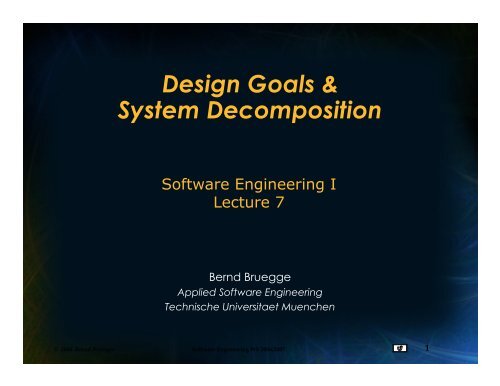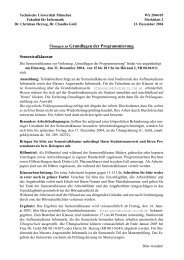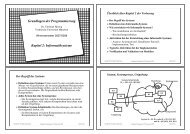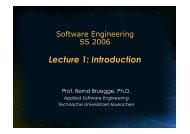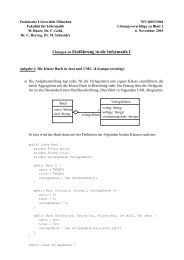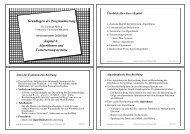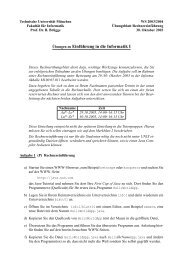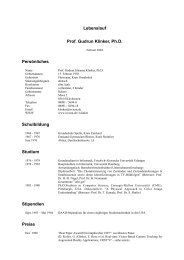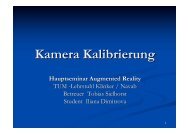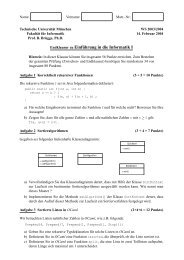Design Goals & System Decomposition
Design Goals & System Decomposition
Design Goals & System Decomposition
You also want an ePaper? Increase the reach of your titles
YUMPU automatically turns print PDFs into web optimized ePapers that Google loves.
<strong>Design</strong> <strong>Goals</strong> &<br />
<strong>System</strong> <strong>Decomposition</strong><br />
Software Engineering I<br />
Lecture 7<br />
Bernd Bruegge<br />
Applied Software Engineering<br />
Technische Universitaet Muenchen<br />
© 2006 Bernd Bruegge Software Engineering WS 2006/2007<br />
1
Where are we?<br />
• We have covered Ch 1 - 3<br />
• We are in the middle of Chapter 4<br />
• Functional modeling: Read again Ch 2, pp. 46 - 51<br />
• Structural modeling: Read again Ch 2, pp.52 - 59<br />
• From use cases to class diagrams<br />
• Identify participatory objects in flow of events descriptions<br />
• Exercise: Apply Abbot’s technique to Fig. 5-7, p. 181<br />
• Identify entity, control and boundary objects<br />
• Heuristics to find these types: Ch 5, Section 5.4<br />
• Notations for dynamic models:<br />
• Interaction-, Collaboration-, Statechart-, Activity diagrams<br />
• Read Ch. 2, pp. 59-67<br />
© 2006 Bernd Bruegge Software Engineering WS 2006/2007<br />
2
<strong>Design</strong> is Difficult<br />
• There are two ways of constructing a software<br />
design (Tony Hoare):<br />
• One way is to make it so simple that there are<br />
obviously no deficiencies,<br />
• and the other way is to make it so complicated that<br />
there are no obvious deficiencies.”<br />
• Corollary (Jostein Gaarder):<br />
• If our brain would be so simple that we can understand<br />
it, we would be too stupid to understand it.<br />
© 2006 Bernd Bruegge Software Engineering WS 2006/2007<br />
3
Why is <strong>Design</strong> so Difficult?<br />
• Analysis: Focuses on the application domain<br />
• <strong>Design</strong>: Focuses on the solution domain<br />
• The solution domain is changing very rapidly<br />
• Halftime knowledge in software engineering: About<br />
3-5 years<br />
• Cost of hardware rapidly sinking<br />
�<strong>Design</strong> knowledge is a moving target<br />
• <strong>Design</strong> window: Time in which design decisions<br />
have to be made.<br />
© 2006 Bernd Bruegge Software Engineering WS 2006/2007<br />
4
The Scope of <strong>System</strong> <strong>Design</strong><br />
• Bridge the gap<br />
• between a problem and<br />
an existing system in a<br />
manageable way<br />
• How?<br />
• Use Divide & Conquer:<br />
1) Identify design goals<br />
2) Model the new system<br />
design as a set of<br />
subsystems<br />
3-8) Address the major<br />
design goals.<br />
© 2006 Bernd Bruegge Software Engineering WS 2006/2007<br />
Problem<br />
<strong>System</strong><br />
<strong>Design</strong><br />
Existing <strong>System</strong><br />
5
<strong>System</strong> <strong>Design</strong>: Eight Issues<br />
1. Identify <strong>Design</strong> <strong>Goals</strong><br />
Additional NFRs<br />
Trade-offs<br />
2. Subsystem <strong>Decomposition</strong><br />
Layers vs Partitions<br />
Coherence & Coupling<br />
3. Identify Concurrency<br />
Identification of<br />
Parallelism<br />
(Processes,<br />
Threads)<br />
4. Hardware/<br />
Software Mapping<br />
Identification of Nodes<br />
Special Purpose <strong>System</strong>s<br />
Buy vs Build<br />
Network Connectivity<br />
<strong>System</strong> <strong>Design</strong><br />
© 2006 Bernd Bruegge Software Engineering WS 2006/2007<br />
5. Persistent Data<br />
Management<br />
Storing Persistent<br />
Objects<br />
Filesystem vs Database<br />
8. Boundary<br />
Conditions<br />
Initialization<br />
Termination<br />
Failure.<br />
7. Software<br />
Control<br />
Monolithic<br />
Event-Driven<br />
Conc. Processes<br />
6. Global Resource<br />
Handlung<br />
Access Control<br />
ACL vs Capabilities<br />
Security<br />
6
Overview<br />
<strong>System</strong> <strong>Design</strong> I (This Lecture)<br />
0. Overview of <strong>System</strong> <strong>Design</strong><br />
1. <strong>Design</strong> <strong>Goals</strong><br />
2. Subsystem <strong>Decomposition</strong> (identifying subsystems)<br />
<strong>System</strong> <strong>Design</strong> II (Lecture 8:Addressing <strong>Design</strong> <strong>Goals</strong>)<br />
3. Concurrency (The more parallelism we can identify the<br />
better)<br />
4. Hardware/Software Mapping: Mapping subsystems to<br />
processors<br />
5. Persistent Data Management (Storing entity objects)<br />
6. Global Resource Handling and Access Control (Who can<br />
access what?)<br />
7. Software Control (Who is in control?)<br />
8. Boundary Conditions (Administrative use cases).<br />
© 2006 Bernd Bruegge Software Engineering WS 2006/2007<br />
7
How the Analysis Models influence <strong>System</strong><br />
<strong>Design</strong><br />
• Nonfunctional Requirements<br />
=> Definition of <strong>Design</strong> <strong>Goals</strong><br />
• Functional model<br />
=> Subsystem <strong>Decomposition</strong><br />
• Object model<br />
=> Hardware/Software Mapping, Persistent Data<br />
Management<br />
• Dynamic model<br />
=> Identification of Concurrency, Global Resource<br />
Handling, Software Control<br />
• Finally: Hardware/Software Mapping<br />
=> Boundary conditions<br />
© 2006 Bernd Bruegge Software Engineering WS 2006/2007<br />
8
From Analysis to<br />
1. <strong>Design</strong> <strong>Goals</strong><br />
Definition<br />
Trade-offs<br />
Nonfunctional<br />
Requirements<br />
2. <strong>System</strong> <strong>Decomposition</strong><br />
Layers vs Partitions<br />
Coherence/Coupling<br />
Functional Model<br />
3. Concurrency<br />
Identification of<br />
Threads<br />
Dynamic<br />
Model<br />
4. Hardware/<br />
Software Mapping<br />
Special Purpose<br />
Buy vs Build<br />
Allocation of Resources<br />
Connectivity<br />
<strong>System</strong> <strong>Design</strong><br />
5. Data<br />
Management<br />
Object Model<br />
© 2006 Bernd Bruegge Software Engineering WS 2006/2007<br />
Persistent Objects<br />
Filesystem vs<br />
Database<br />
8. Boundary<br />
Conditions<br />
Initialization<br />
Termination<br />
Failure<br />
Functional Model<br />
7. Software<br />
Control<br />
Monolithic<br />
Event-Driven<br />
Conc. Processes<br />
Dynamic<br />
Model<br />
6. Global Resource<br />
Handlung<br />
Access Control List<br />
vs Capabilities<br />
Security<br />
9
Example of <strong>Design</strong> <strong>Goals</strong><br />
• Reliability<br />
• Modifiability<br />
• Maintainability<br />
• Understandability<br />
• Adaptability<br />
• Reusability<br />
• Efficiency<br />
• Portability<br />
• Traceability of<br />
requirements<br />
• Fault tolerance<br />
• Backward-compatibility<br />
• Cost-effectiveness<br />
• Robustness<br />
• High-performance<br />
© 2006 Bernd Bruegge Software Engineering WS 2006/2007<br />
� Good documentation<br />
� Well-defined interfaces<br />
� User-friendliness<br />
� Reuse of components<br />
� Rapid development<br />
� Minimum number of errors<br />
� Readability<br />
� Ease of learning<br />
� Ease of remembering<br />
� Ease of use<br />
� Increased productivity<br />
� Low-cost<br />
� Flexibility<br />
10
Stakeholders have different <strong>Design</strong> <strong>Goals</strong><br />
Low cost<br />
Increased Productivity<br />
Backward-Compatibility<br />
Traceability of requirements<br />
Rapid development<br />
Flexibility<br />
Client<br />
(Customer)<br />
Runtime<br />
Efficiency<br />
Reliability<br />
Minimum # of errors<br />
Modifiability, Readability<br />
Reusability, Adaptability<br />
Well-defined interfaces<br />
© 2006 Bernd Bruegge Software Engineering WS 2006/2007<br />
Portability<br />
Good Documentation<br />
Functionality<br />
User-friendliness<br />
Usability<br />
Ease of learning<br />
Fault tolerant<br />
Robustness<br />
Developer/<br />
Maintainer<br />
11<br />
End<br />
User
Typical <strong>Design</strong> Trade-offs<br />
• Functionality v. Usability<br />
• Cost v. Robustness<br />
• Efficiency v. Portability<br />
• Rapid development v. Functionality<br />
• Cost v. Reusability<br />
• Backward Compatibility v. Readability<br />
© 2006 Bernd Bruegge Software Engineering WS 2006/2007<br />
12
Subsystem <strong>Decomposition</strong><br />
• Subsystem<br />
• Collection of classes, associations, operations, events<br />
and constraints that are closely interrelated with each<br />
other<br />
• The objects and classes from the object model are the<br />
“seeds” for the subsystems<br />
• In UML subsystems are modeled as packages<br />
• Service<br />
• A set of named operations that share a common purpose<br />
• The origin (“seed”) for services are the use cases from<br />
the functional model<br />
• Services are defined during system design.<br />
© 2006 Bernd Bruegge Software Engineering WS 2006/2007<br />
13
Component<br />
Management<br />
User Interface<br />
Manages advertisement<br />
banners & sponsorships<br />
Advertisement<br />
Maintains state<br />
during matches<br />
Tournament<br />
Adds games, styles,<br />
and expert rating<br />
formulas<br />
Session<br />
Management<br />
© 2006 Bernd Bruegge Software Engineering WS 2006/2007<br />
Example: Services<br />
provided by the<br />
ARENA Subsystems<br />
Manages<br />
tournaments,promotions,<br />
applications<br />
Services<br />
are described<br />
by subsystem interfaces<br />
Tournament<br />
Statistics<br />
Stores results of<br />
archived<br />
tournaments<br />
Administers user<br />
accounts<br />
User Management<br />
User Directory<br />
Stores user profiles<br />
(contact info &<br />
subscriptions)<br />
14
Subsystem Interfaces vs API<br />
• Subsystem interface: Set of fully typed UML<br />
operations<br />
• Specifies the interaction and information flow from and<br />
to subsystem boundaries, but not inside the subsystem<br />
• Refinement of service, should be well-defined and small<br />
• Subsystem interfaces are defined during object design<br />
• Application programmer’s interface (API)<br />
• The API is the specification of the subsystem interface in<br />
a specific programming language<br />
• APIs are defined during implementation<br />
• The terms subsystem interface and API are often<br />
confused with each other<br />
• The term API should not be used during system design<br />
and object design, but only during implementation.<br />
© 2006 Bernd Bruegge Software Engineering WS 2006/2007<br />
15
Example: Notification subsystem<br />
• Service provided by Notification Subsystem<br />
• LookupChannel()<br />
• SubscribeToChannel()<br />
• SendNotice()<br />
• UnscubscribeFromChannel()<br />
• Subsystem Interface of Notification Subsystem<br />
in UML<br />
Left as an Exercise<br />
• API of Notification Subsystem in Java<br />
Left as an Exercise<br />
© 2006 Bernd Bruegge Software Engineering WS 2006/2007<br />
Notification<br />
16
Subsystem Interface Object<br />
• Good design: The subsystem interface object<br />
describes all the services of the subsystem<br />
interface<br />
• Subsystem Interface Object<br />
• The set of public operations provided by a subsystem<br />
Subsystem Interface Objects can be realized with the<br />
Façade pattern (=> lecture on design patterns).<br />
© 2006 Bernd Bruegge Software Engineering WS 2006/2007<br />
17
Relationships between Subsystems<br />
• Layer relationships<br />
• Layer A “depends on” Layer B (compile time property)<br />
• Example: Build dependencies (make, ant, maven)<br />
• Layer A “calls” Layer B (runtime property)<br />
• Example: Client/Server dependency<br />
• Can the client and server layers run on the same machine?<br />
• Think about the layers, not about the hardware mapping!<br />
• Partition relationship<br />
• The subsystems have mutual knowledge about each other<br />
• A can call services in B, B can call services in A<br />
• Example: Peer-to-Peer systems<br />
• UML convention:<br />
• Runtime dependencies are associations with dashed lines<br />
• Compile time dependencies are associations with solid lines.<br />
© 2006 Bernd Bruegge Software Engineering WS 2006/2007<br />
19
Example of a Subsystem <strong>Decomposition</strong><br />
Partition<br />
relationship<br />
B:Subsystem<br />
A:Subsystem<br />
C:Subsystem<br />
E:Subsystem F:Subsystem<br />
G:Subsystem<br />
Layer<br />
Relationship<br />
„calls“<br />
© 2006 Bernd Bruegge Software Engineering WS 2006/2007<br />
Layer<br />
Relationship<br />
„depends on“<br />
D:Subsystem<br />
Layer 1<br />
Layer 2<br />
Layer 3<br />
20
Advertisement<br />
Component<br />
Management<br />
User Interface<br />
Session<br />
Management<br />
Tournament<br />
© 2006 Bernd Bruegge Software Engineering WS 2006/2007<br />
ARENA Subsystem<br />
<strong>Decomposition</strong><br />
Tournament<br />
Statistics<br />
User Management<br />
User Directory<br />
21
Example of a Bad Subsystem<br />
<strong>Decomposition</strong><br />
Advertisement<br />
User Interface<br />
Tournament<br />
Session<br />
Management<br />
© 2006 Bernd Bruegge Software Engineering WS 2006/2007<br />
Component<br />
Management<br />
Tournament<br />
Statistics<br />
User Management<br />
22
Good <strong>Design</strong>: The <strong>System</strong> as set of Interface<br />
Objects<br />
User Interface<br />
User<br />
Management<br />
Advertisement<br />
Tournament<br />
Statistics<br />
Subsystem Interface Objects<br />
© 2006 Bernd Bruegge Software Engineering WS 2006/2007<br />
Tournament<br />
Component<br />
Management<br />
Session<br />
Management<br />
23
Virtual Machine<br />
• The terms layer and virtual machine can be used<br />
interchangeably<br />
• Also sometimes called “level of abstraction”.<br />
• A virtual machine is an abstraction that provides a set of<br />
attributes and operations<br />
• A virtual machine is a subsystem connected to<br />
higher and lower level virtual machines by<br />
"provides services for" associations.<br />
© 2006 Bernd Bruegge Software Engineering WS 2006/2007<br />
24
Building <strong>System</strong>s as a Set of Virtual Machines<br />
A system is a hierarchy of virtual machines, each using<br />
language primitives offered by the lower machines.<br />
Operating <strong>System</strong>, Libraries<br />
Virtual Machine 4 .<br />
Virtual Machine 3<br />
Virtual Machine 2<br />
Virtual Machine 1<br />
Existing <strong>System</strong>
Building <strong>System</strong>s as a Set of Virtual Machines<br />
A system is a hierarchy of virtual machines, each using<br />
language primitives offered by the lower machines.<br />
Operating <strong>System</strong>, Libraries<br />
Virtual Machine4<br />
Virtual Machine 3<br />
Virtual Machine 2<br />
Virtual Machine 1<br />
Existing <strong>System</strong>
Closed Architecture (Opaque Layering)<br />
• Each virtual machine<br />
can only call operations<br />
from the layer below<br />
<strong>Design</strong> goals: Maintainability,<br />
flexibility.<br />
© 2006 Bernd Bruegge Software Engineering WS 2006/2007<br />
C1ass1<br />
attr<br />
op<br />
Class A<br />
attr<br />
op<br />
C1assC<br />
attr<br />
op<br />
C1ass2<br />
attr<br />
op<br />
C1assE<br />
attr<br />
op<br />
C1ass3<br />
attr<br />
op<br />
C1assD<br />
attr<br />
op<br />
C1assF<br />
attr<br />
op<br />
C1ass B<br />
attr<br />
op<br />
VM4<br />
VM3<br />
VM2<br />
VM1<br />
27
Opaque Layering in ARENA<br />
Interface<br />
Application Logic<br />
UserManagement<br />
Storage<br />
AdvertisementManagement<br />
ArenaStorage<br />
ArenaClient<br />
ArenaServer<br />
© 2006 Bernd Bruegge Software Engineering WS 2006/2007<br />
GameManagement<br />
TournamentManagement<br />
Notification<br />
28
Open Architecture (Transparent Layering)<br />
• Each virtual machine<br />
can call operations<br />
from any layer below<br />
<strong>Design</strong> goal: Runtime<br />
efficiency<br />
© 2006 Bernd Bruegge Software Engineering WS 2006/2007<br />
C1<br />
attr<br />
op<br />
C1<br />
attr<br />
op<br />
C1<br />
attr<br />
op<br />
C1<br />
attr<br />
op<br />
C1<br />
attr<br />
op<br />
C1<br />
attr<br />
op<br />
C1<br />
attr<br />
op<br />
C1<br />
attr<br />
op<br />
C1<br />
attr<br />
op<br />
VM1<br />
VM2<br />
VM3<br />
VM4<br />
29
Properties of Layered <strong>System</strong>s<br />
• Layered systems are hierarchical. This is a<br />
desirable design, because the hierarchy reduces<br />
complexity<br />
• low coupling<br />
• Closed architectures are more portable<br />
• Open architectures are more efficient<br />
• Layered systems often have a chicken-and egg<br />
Symbol Table<br />
problem<br />
How do you open the<br />
symbol table when you are<br />
debugging the File<br />
<strong>System</strong>?<br />
A: Symbolic Debugger<br />
© 2006 Bernd Bruegge Software Engineering WS 2006/2007<br />
D: File <strong>System</strong><br />
G: Operating <strong>System</strong><br />
30
Coupling and Coherence of Subsystems<br />
• Goal: Reduce system complexity while allowing<br />
change<br />
• Coherence measures dependency among classes<br />
• High coherence: The classes in the subsystem perform<br />
similar tasks and are related to each other via many<br />
associations<br />
• Low coherence: Lots of miscellaneous and auxiliary<br />
classes, almost no associations<br />
• Coupling measures dependency among<br />
subsystems<br />
• High coupling: Changes to one subsystem will have high<br />
impact on the other subsystem<br />
• Low coupling: A change in one subsystem does not affect<br />
any other subsystem.<br />
© 2006 Bernd Bruegge Software Engineering WS 2006/2007<br />
31
Coupling and Coherence of Subsystems<br />
• Goal: Reduce system complexity while allowing<br />
change<br />
• Coherence measures dependency among classes<br />
• High coherence: The classes in the subsystem perform<br />
similar tasks and are related to each other via<br />
associations<br />
• Low coherence: Lots of miscellaneous and auxiliary<br />
classes, no associations<br />
• Coupling measures dependency among<br />
subsystems<br />
• High coupling: Changes to one subsystem will have high<br />
impact on the other subsystem<br />
• Low coupling: A change in one subsystem does not affect<br />
any other subsystem<br />
© 2006 Bernd Bruegge Software Engineering WS 2006/2007<br />
32
Coupling and Coherence of Subsystems<br />
Good <strong>Design</strong><br />
• Goal: Reduce system complexity while allowing<br />
change<br />
• Coherence measures dependency among classes<br />
• High coherence: The classes in the subsystem perform<br />
similar tasks and are related to each other via<br />
associations<br />
• Low coherence: Lots of miscellaneous and auxiliary<br />
classes, no associations<br />
• Coupling measures dependency among<br />
subsystems<br />
• High coupling: Changes to one subsystem will have high<br />
impact on the other subsystem<br />
• Low coupling: A change in one subsystem does not affect<br />
any other subsystem<br />
© 2006 Bernd Bruegge Software Engineering WS 2006/2007<br />
33
How to achieve high Coherence<br />
• High coherence can be achieved if most of the<br />
interaction is within subsystems, rather than<br />
across subsystem boundaries<br />
• Questions to ask:<br />
• Does one subsystem always call the other for the<br />
service?<br />
• Can the subsystems be hierarchically ordered (in<br />
layers)?<br />
• Which of the subsystems call each other for services?<br />
• Can this be avoided by restructuring the<br />
subsystems or changing the subsystem interface?<br />
© 2006 Bernd Bruegge Software Engineering WS 2006/2007<br />
34
How to achieve Low Coupling<br />
• Low coupling can be achieved if a calling class<br />
does not know about the internals of the called<br />
class<br />
• Questions to ask:<br />
• Does the calling class really have to know any<br />
attributes of classes in the lower layers?<br />
• Is it possible that the calling class calls only operations<br />
of the lower level classes?<br />
Principle of information hiding (Parnas)<br />
© 2006 Bernd Bruegge Software Engineering WS 2006/2007<br />
35
Additional Readings<br />
• E.W. Dijkstra,<br />
• “The structure of the T.H.E Multiprogramming system,<br />
Communications of the ACM, 18(8), pp. 453-457,<br />
1968<br />
• D. Parnas<br />
• “On the criteria to be used in decomposing systems<br />
into modules, CACM, 15(12), pp. 1053-1058, 1972.<br />
© 2006 Bernd Bruegge Software Engineering WS 2006/2007<br />
36
Summary<br />
• <strong>System</strong> <strong>Design</strong><br />
• Reduce gap between problem and an existing machine<br />
• Decomposes the overall system into manageable parts<br />
• Uses the principles of cohesion and coherence<br />
• <strong>Design</strong> <strong>Goals</strong> Definition<br />
• Describes the important system qualities<br />
• Defines the values against which options are evaluated<br />
• Subsystem <strong>Decomposition</strong><br />
• Results into a set of loosely dependent parts which<br />
make up the system<br />
• Layers and Partitions<br />
• Virtual machine<br />
• High coherence and low coupling<br />
© 2006 Bernd Bruegge Software Engineering WS 2006/2007<br />
37


